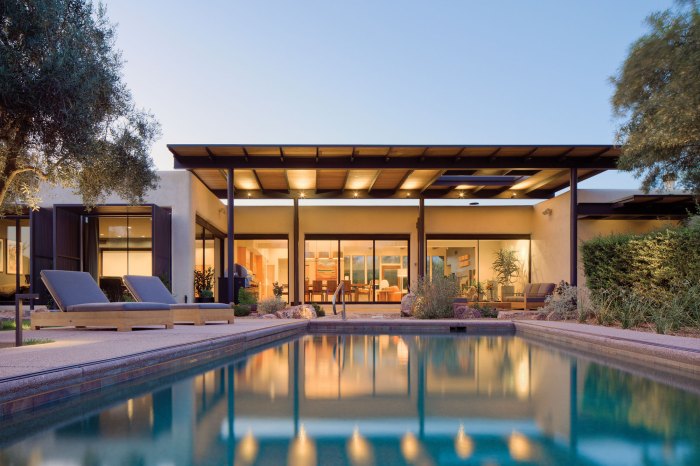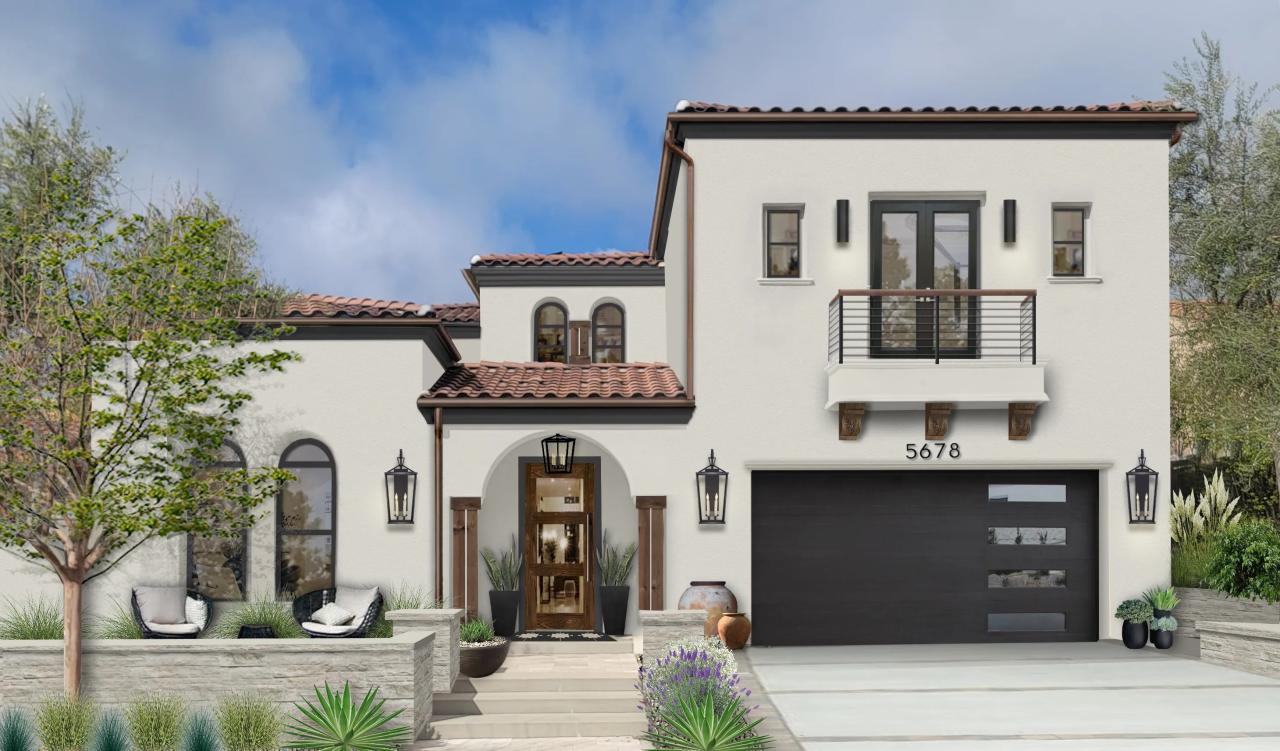Defining Modern Spanish House Design

Modern Spanish house design represents a contemporary interpretation of traditional Spanish architectural elements, blending historical influences with modern aesthetics and functionality. It retains the charm and character of its heritage while incorporating contemporary materials and design principles. This results in homes that are both visually striking and comfortable for modern living.
Key Characteristics of Modern Spanish Architecture
Modern Spanish architecture retains several key characteristics of its historical counterpart, but with a streamlined and updated approach. Common features include low-pitched, red tile roofs; stucco or plaster exteriors; arched doorways and windows; and the incorporation of courtyards or patios to bring the outdoors in. However, unlike traditional Spanish styles, modern interpretations often feature cleaner lines, larger windows to maximize natural light, and a more open floor plan.
The emphasis is on creating a sense of spaciousness and indoor-outdoor flow, often achieved through the strategic use of glass and open-concept living areas.
Comparison of Modern and Traditional Spanish Design
Traditional Spanish architecture, particularly in regions like Spain and Mexico, is characterized by intricate detailing, ornate ornamentation, and a focus on craftsmanship. Think elaborate ironwork, decorative tilework, and richly textured surfaces. Modern Spanish design, in contrast, simplifies these elements. While it might incorporate some traditional motifs, it does so in a more understated way. The focus shifts from elaborate decoration to clean lines, functionality, and a sophisticated simplicity.
For example, a traditional Spanish home might feature heavily carved wooden doors, while a modern version might utilize a sleek, minimalist door with a simple arch. The overall effect is a more contemporary and less overtly decorative aesthetic.
Use of Natural Materials in Modern Spanish Homes
Natural materials play a crucial role in modern Spanish home design, echoing the traditional emphasis on local resources. Stucco remains a popular exterior choice, offering both durability and a textured surface. Wood, often in warm tones like cedar or redwood, is frequently used for beams, flooring, and accents, adding warmth and visual interest. Stone, particularly in lighter shades, is often incorporated into exterior walls, walkways, and fireplaces, adding a touch of rustic elegance.
These natural materials are often combined with modern materials such as glass and steel, creating a harmonious blend of old and new.
Typical Color Palettes in Modern Spanish House Design
Modern Spanish homes often employ earthy and warm color palettes that complement the natural materials used in construction. Neutral tones such as beige, cream, and terracotta are prevalent, reflecting the colors of the surrounding landscape. These are often accented with deeper, richer hues like deep reds, burnt oranges, or olive greens. The overall effect is a palette that feels both inviting and sophisticated, reflecting the warmth and vibrancy of the Spanish aesthetic.
Modern Spanish house design often incorporates stucco exteriors, terracotta roofs, and arched doorways, creating a distinctive aesthetic. For a broader visual understanding of architectural styles, including stunning examples of modern Spanish homes, you might find it helpful to browse through a collection of photos of house design online. Returning to the specifics of modern Spanish design, the emphasis is often on creating a seamless blend of indoor and outdoor living spaces, frequently incorporating courtyards or patios.
White is also frequently used, especially for trim and detailing, to create contrast and enhance the sense of light and space.
Comparison of Three Modern Spanish Architectural Styles
| Style | Key Characteristics | Materials | Color Palette |
|---|---|---|---|
| Mediterranean Modern | Emphasis on indoor-outdoor living, open floor plans, white stucco exteriors, arched openings. | Stucco, wood, tile, stone | Whites, creams, blues, terracotta accents |
| Contemporary Spanish Ranch | Low-slung profiles, expansive windows, integration of natural landscaping, simple lines. | Stucco, wood, stone, metal | Earthy tones, browns, greens, beige |
| Modern Southwestern Spanish | Strong geometric forms, incorporation of local materials, blend of traditional and contemporary elements. | Adobe, wood beams, plaster, stone | Warm earth tones, terracotta, reds, yellows |
Interior Design Elements

The interior of a modern Spanish house seamlessly blends traditional elements with contemporary aesthetics, creating a space that is both luxurious and inviting. The use of natural materials, warm color palettes, and carefully chosen furniture pieces are key to achieving this balance. This section will explore the key elements that define the interior design of a modern Spanish home.
Modern Spanish Living Room Design, Modern spanish house design
A modern Spanish living room often features a relaxed and comfortable atmosphere. Imagine a spacious room with high ceilings, perhaps incorporating exposed wooden beams. The furniture might include a low-slung, modular sofa upholstered in a rich, textured fabric like linen or velvet in a warm neutral tone, such as terracotta or a deep beige. A statement piece, such as a hand-carved wooden coffee table or a beautifully patterned rug, adds character.
Lighting plays a crucial role; consider incorporating recessed lighting for ambient illumination, complemented by strategically placed floor lamps with woven shades for a warmer, more intimate feel. Decorative elements could include large ceramic pots with lush greenery, hand-painted artwork showcasing Spanish landscapes, or a collection of vintage Spanish pottery displayed on open shelving.
Modern Spanish Kitchen Designs
Modern Spanish kitchens often favor a clean, functional layout. A common design might include an open-plan kitchen seamlessly integrated with the dining and living areas. Appliance choices often lean towards sleek, stainless steel models, while countertops might be crafted from natural materials like granite or marble, reflecting the Spanish appreciation for natural beauty. Custom-made cabinetry, perhaps featuring warm wood tones or a painted finish in a sophisticated shade of white or muted green, provides ample storage.
A large island, ideal for both food preparation and casual dining, is often a central feature.
Incorporating Traditional Spanish Elements into Modern Design
Traditional Spanish design elements can be subtly incorporated to enrich a modern aesthetic. This might involve using handcrafted tiles, perhaps in a muted pattern, as a backsplash in the kitchen or as an accent wall in a bathroom. Intricate ironwork, such as decorative light fixtures or window grilles, adds a touch of old-world charm. The use of natural materials, such as exposed brick, stucco, or terracotta flooring, also evokes a sense of Spanish heritage without overwhelming the modern design.
These elements are carefully curated to complement, rather than dominate, the contemporary style.
Textiles and Patterns in Modern Spanish Interior Design
Textiles and patterns play a significant role in establishing the ambiance of a modern Spanish interior. Think rich, textured fabrics like linen, velvet, and wool in warm earth tones – terracotta, ochre, olive green, and deep blues. Patterns might incorporate traditional Spanish motifs, such as geometric designs or floral patterns inspired by Spanish flora, but often in a simplified, modern interpretation.
These patterns could be found in rugs, throw pillows, curtains, or even on upholstered furniture, adding depth and visual interest to the space. The key is to use these patterns sparingly, ensuring they complement rather than clash with the overall modern aesthetic.
Five Key Interior Design Features of a Modern Spanish Home
The following five features are crucial in defining the aesthetic of a modern Spanish home:
- Natural Materials: Extensive use of materials like wood, stone, and terracotta creates a warm and inviting atmosphere.
- Warm Color Palette: Earthy tones such as terracotta, ochre, beige, and olive green dominate the color scheme.
- Handcrafted Elements: Incorporating handcrafted tiles, ironwork, or furniture adds character and authenticity.
- Open Floor Plans: Spacious, open-concept layouts maximize light and create a sense of flow.
- Subtle Traditional Motifs: Traditional Spanish patterns and designs are incorporated subtly, avoiding an overly traditional look.
Question & Answer Hub: Modern Spanish House Design
What are the common misconceptions about Modern Spanish house design?
A common misconception is that all Modern Spanish homes are ornate and heavily decorated. While traditional Spanish styles often feature elaborate details, modern interpretations prioritize clean lines and minimalist aesthetics, though still incorporating key elements like arches and stucco.
How much does it cost to build a modern Spanish style home?
The cost varies greatly depending on size, location, materials chosen, and level of customization. It’s best to consult with local builders and architects for accurate cost estimations.
Are modern Spanish homes suitable for all climates?
While the design is adaptable, regional variations are crucial. Design elements like passive solar features and materials need to be tailored to the specific climate to ensure energy efficiency and comfort.
What are some popular modern Spanish home styles?
Popular styles include minimalist interpretations emphasizing clean lines and stucco exteriors, those incorporating significant use of wood and stone, and those showcasing a blend of traditional and contemporary elements.
